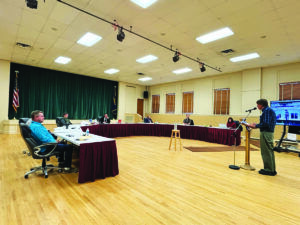
by Nathan Boddy
The Hamilton City Council met on Tuesday, May 7th, transitioning from a budget meeting to the regular meeting at 7:00. While the agenda was light, the council was able to approve a new IT contract, payment for a replacement motor on one of the city’s water pumps, and confirm regular employment status for two members of the Public Works Department.
Public Works Director, Donny Ramer, also updated the councilors on utility work on 3rd Street, the sewer extension toward the airport, and informed them that a traffic calming project on State Street will begin later in the week.
The council also welcomed Peter Reynolds, President of the Bitterroot Climate Action Group, who gave the council a summary of their report entitled, ‘Building Resilience.’ The report grew out of the Bitterroot Resilience Forum, a gathering of more than 70 area citizens and representatives of various groups and government agencies which took place last fall. The forum, which was funded in part by a grant from the National Oceanic and Atmospheric Administration, was established to create a framework for conversations and planned actions for how the Bitterroot Valley can position itself for the changes inherent in a warming climate. The forum was a component of the ResilienceMT project of the University of Montana, and the Bitterroot Climate Action Group was the local non-profit chosen to partner with the forum.
Reynolds read aloud from portions of the report. The executive summary itself states that, according to research conducted by Dr. Bruce Maxwell of Montana State University, a warming climate will have multiple impacts upon the Bitterroot Valley in the foreseeable future. Perhaps most notable will be impacts upon water and those pertaining to wildfire. A warming climate, the report states, will see more precipitation coming in the form of rain rather than snow. This difference means faster runoff in the spring, and could lead to water shortages in later summer. Higher temperatures and less water also leads to warmer streamflows, placing stress on fish and the recreation industry that thrives from angling. Higher probability for wildfire means higher potential for poor air quality and the associated negative health impacts.
The report chronicles how the forum broke into various discussion groups wherein participants were asked to identify vulnerabilities that the valley may have to various potential impacts of climate change. The groups were also encouraged to identify actions to increase the valley’s resilience to climate change. Some of the suggestions were, “commitment of elected officials, government agencies, local businesses, educators, nonprofits, non-governmental organizations and the general public,” to resilience planning through education, appropriately crafted public policy, and dedication of the agricultural sector and home owners toward policies for water conservation and carbon sequestration. The report follows with specific, point by point action measures that could be used to bring the valley closer to addressing the key findings of vulnerabilities. Many specific recommendations for each of the vulnerabilities are included within the report.
Reynolds concluded by encouraging the Hamilton City Council to take concrete steps to prepare for the changing climate, citing as examples other municipalities that have taken specific policy steps to do so. These steps could range from emergency action plans for extreme heat events to procurement policies geared around renewable technology or planning for green space and tree cover within municipal planning documents.
“I hope you’ll read the resilience report and come back with suggestions,” he said. “Climate change is happening now and will interrupt our best laid plans.”
To view the documentary and download a copy of the report produced by Bitterroot Resilience, visit their website at: https://bitterrootcag.org/resiliencemt/